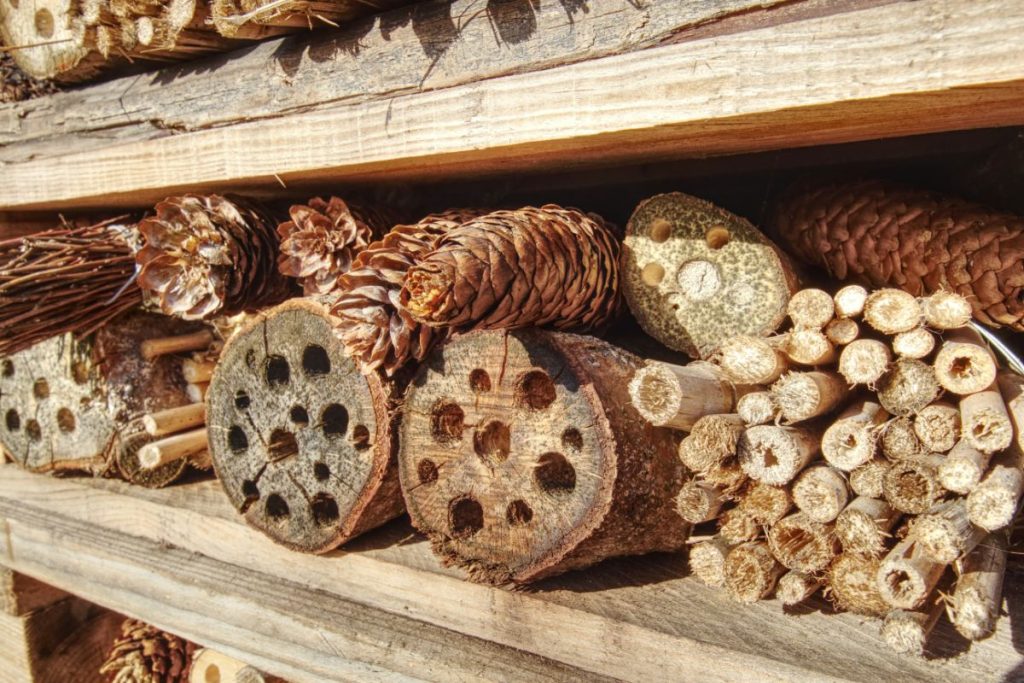How to Make a Bug Hotel and Invite Fantastic Creatures into Your Garden
May 1, 2025

Insect life is vital to a thriving garden ecosystem. From pollination to pest control, bugs play a crucial role in keeping your outdoor space healthy and full of life.
One simple, eco-friendly way to support garden biodiversity is by building your own bug hotel. Not only is it a rewarding activity for nature lovers, but it’s also a fantastic project for children.
What Is a Bug Hotel?
A bug hotel, also known as an insect hotel or bug house, is a manmade structure that provides shelter and nesting space for a variety of beneficial insects. These habitats are made from natural or recycled materials and attract creatures such as:
- Solitary bees (important pollinators)
- Ladybirds and lacewings (natural pest controllers)
- Woodlice and beetles (decomposers that enrich soil)
- Spiders and other garden helpers
Bug hotels not only support biodiversity but also encourage healthy plant growth and reduce the need for chemical pest control.
Where to Build Your Bug Hotel
Choosing the right spot can make all the difference. Here are some tips:
- Sunny and sheltered: Most insects prefer warmth and protection from wind and rain.
- Near plants: Placing your hotel close to flowers, shrubs, or vegetable patches helps attract pollinators.
- Away from disturbance: Try to avoid placing it near paths or frequently used areas.
For maximum success, different bugs need different conditions—bees love the sun, while beetles and woodlice prefer cool, damp spots.
Materials You’ll Need
You can build a bug hotel from everyday items and natural materials. Here’s a list to get you started:
- Wooden pallets or boxes (for structure)
- Hollow stems and bamboo canes (ideal for solitary bees)
- Pinecones, straw, dry leaves, and twigs (shelter and insulation)
- Bricks with holes or clay pots (good for beetles and spiders)
- Bark, wood chips, and cardboard
- String, nails, or glue (for securing materials)
When gathering materials, choose untreated wood and avoid anything toxic. The more variety, the more insects you’ll attract.
How to Make a Bug Hotel: Step-by-Step
Ready to get started? Follow these simple steps to build your own garden insect haven:
- Create the Frame
Use wooden pallets, a crate, or stackable boxes to make a solid base. The hotel can be as tall or wide as you like.
- Divide Into Sections
Partition the space into smaller chambers using wood slats or dividers. Each section will house different materials.
- Add Natural Fillings
Fill each compartment with a mix of bug-friendly materials like bamboo, bark, straw, pinecones, and bricks.
- Secure the Structure
Use string or nails to keep materials in place. Ensure the hotel is sturdy and won’t collapse in bad weather.
- Place in the Garden
Position the bug hotel in your chosen spot. Make sure it’s stable and slightly raised off the ground to avoid damp.
- Add Some Decorations
Add things like mini toy diggers or models to make it look like there is a miniature community working on your bug hotel outside.
Bug Hotel Ideas for All Ages
Looking for inspiration? These creative bug hotel ideas offer something for everyone:
- Rustic pallet stack: Great for large gardens, stack multiple pallets filled with materials.
- Hanging bottle bug hotel: Cut plastic bottles in half, fill them with twigs and canes, and hang from trees or fences.
- Bee brick wall: Use bricks with holes or drill into wood blocks to create a bee nesting wall.
- Children’s homemade bug hotel: Use a shoebox or small crate and let kids fill it with twigs, dry grass, and cones. Encourage them to decorate it with natural paints or leaves.
Bug hotels can be as simple or artistic as you like; there’s no one-size-fits-all.
Which Insects Will You Attract?
Here’s a quick look at the “fantastic creatures” you’re likely to meet:
- Solitary Bees – Gentle and vital pollinators that nest in hollow stems or drilled wood.
- Ladybirds – Feed on aphids and help protect plants.
- Lacewings – Green, delicate insects that prey on soft-bodied pests.
- Beetles & Woodlice – Break down dead matter and enrich the soil.
- Spiders – Natural pest control experts.
By providing shelter, you’re helping protect threatened species and encouraging a balanced ecosystem.
Caring for Your Bug Hotel
Once built, your bug hotel requires very little maintenance, but here are a few helpful tips:
- Keep it dry: Tilt the roof or add a waterproof layer to stop materials from becoming waterlogged.
- Replace decayed materials: Over time, some fillings will need refreshing to remain effective.
- Observe and learn: Gently watch your bug hotel over the seasons. You’ll learn what insects are most active and which materials they prefer.
In winter, many insects use bug hotels to hibernate, so avoid moving or disturbing it during colder months.
A Fun and Educational Project
Building a bug hotel is a brilliant way to connect with nature for families. A children’s homemade bug hotel not only encourages outdoor play and creativity but also teaches children about wildlife and sustainability. It’s an ideal school project or weekend garden activity.
Get Creative with JCB Explore
Bug hotels are more than just a garden feature, they’re a way to invite nature into your space, support struggling insect populations, and make your garden thrive. Whether you’re a seasoned gardener or trying your first eco project with the kids, knowing how to make a bug hotel is a rewarding, accessible way to give back to nature.
Start collecting your materials today and create a haven for some of the garden’s most fantastic creatures.




